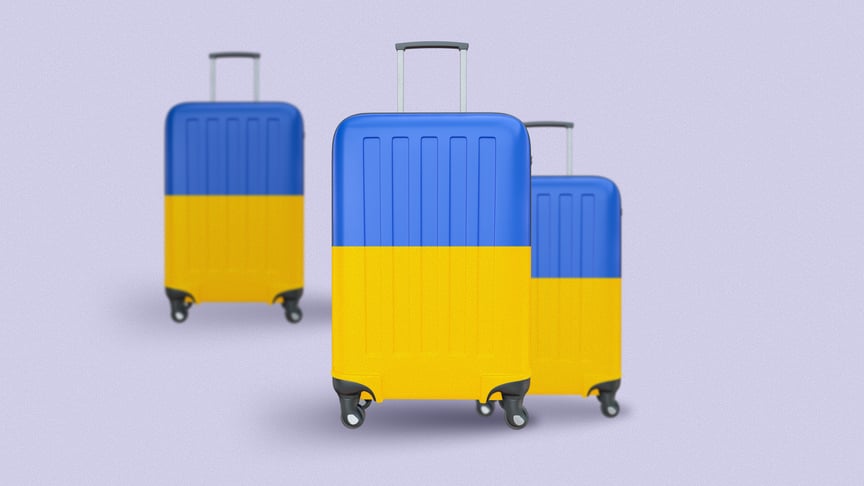100,000 Ukrainians return home every six months: What drives them?

“In three years, I never fully adapted. I worked online, so I didn’t need to learn the language, and thanks to technology, my friends were online too,” says Dasha Yushkevych, a 28-year-old customer support manager, explaining her decision to return to Ukraine after three years in Poland, where she moved at her mother’s urging following the start of the full-scale war.
Another reason for her return was a relationship.
“I planned to come back in the fall, but things didn’t go as planned, so I had to return earlier,” Dasha continues. “A close person joined the military, and I’d once promised, ‘If you go fight, I’ll leave everything behind and take care of your cat.’ So when his basic combat training started, I began the process of moving back.”
While more Ukrainians still leave the country than return, many are choosing to come back. According to the International Organization for Migration (IOM), from February to September 2022, over 343,000 Ukrainians returned from abroad; from October 2022 to March 2023, nearly 270,000; and from April to September 2023, about 122,000. Since then, the number of returnees has stabilized at roughly 100,000 every six months. In total, over 1.1 million Ukrainian citizens have returned.
Half of the returnees are people with at least one child, and they are younger than Ukraine’s average age of 43. Recently, the share of returnees over 60 has risen to 26%.
As of now, according to the IOM, 5.6 million Ukrainians who fled due to the war remain abroad, with 5.1 million in Europe.
This hromadske report explores the reasons for returning to Ukraine, the challenges faced, and the geography of return.
Why do Ukrainians return?
Seventy percent of Ukrainian returnees surveyed by the IOM cite the desire to reunite with family and friends or to be home as their primary reason. There’s no indication yet that attitudes toward the war among Ukrainian refugees have shifted significantly. Only 8% believe the security situation in Ukraine has improved, though 21% of those who returned to their homes share this view.
In my opinion, for most people, the desire to reunite with family and return to their homeland is indeed the main factor in returning. While surveys can sometimes reflect ‘socially desirable responses,’ where people say what’s expected rather than the truth, in this case, I believe these responses are genuine.Dariya Mykhailyshyna, researcher at the Kyiv School of Economics
“But these are subjective reasons, accounting for 71% of responses from surveyed migrants. If they’re subjective, it means external, objective factors could prompt someone to decide to leave again,” says Andriy Haidutskyi, a migration expert.
Almost 200 years ago, Alfred Nobel said, ‘My home is where I work.’ With globalization, solutions to housing rental issues worldwide, and the rise of the ‘digital nomad’ trend, more people see their home as where higher-paying jobs are, not their homeland.Andriy Haidutskyi, migration expert
Maryna Dumanchuk, a 41-year-old pharmaceutical export specialist, returned to Ukraine from Sweden, where she had a good job, in late 2022. She had fled to Sweden because her previous employer’s facilities were in Bakhmut, near the rapidly advancing front line.
Her return was driven by relationships. “I was most worried about my family and my partner. When you read about shelling and message your loved ones but get no reply, every second drives you crazy because you don’t know if they’re okay. I was so stressed that I decided a calm life abroad wasn’t as important as being with the person I love,” she says.
Yanina Yurchuk, a 39-year-old logistics company employee, fled to the UK after the war began but returned in May 2023.
“My daughter hadn’t seen her father or grandmothers. In the UK, it was just the two of us. There were lots of Ukrainians, friends, a community, trips—it was fun, but my family wasn’t there,” Yanina says. She lists three main reasons for her decision: separation from family, housing challenges in the UK, and ties to her employer in Ukraine.
Her case is illustrative, as not only family ties but other factors play a significant role in decisions to return. In the IOM survey, 28% of returnees cited job opportunities in Ukraine, and 23% mentioned access to housing as key reasons for coming back.
Most returnees from EU countries point to economic and social difficulties and tensions in their host countries. Ten percent say they didn’t earn enough in Europe to live comfortably, and 5% report challenges connecting with locals or making genuine friends.
“Maybe they didn’t know the language well enough to understand what locals were saying,” says Vasyl Voskoboynyk, head of the Migration Policy Office. Knowing English alone may not suffice, as Europeans primarily speak their native languages, switching to English only when needed.
In my view, one reason for returning is that in Ukraine, you can be somebody, while abroad, gaining social status is much harder. Those who stay abroad are the 20% who know the language, have quickly retrained, acquired new professions, or legalized their credentials. They’re the ones who won’t come back. Kyrylo Kryvolap, managing partner of the consulting company Civitta and migration specialist
Challenges of returning
Before returning, people try to address three main issues: securing funds for the journey, finding housing, and finding work in Ukraine. If even one of these remains unresolved, many stay abroad, either temporarily or permanently.
Most returnees have housing in Ukraine, which acts like a magnet, offering an alternative to rented accommodations abroad. According to the IOM, 90% of returnees surveyed at the border between July and November 2024 said they were returning to the same housing (owned or rented) they left after the war began. Five percent plan to stay with relatives, while 15% report their housing was damaged or destroyed by the war.
“In Ukraine, we essentially lack a modern social housing market. This needs to change. In the West, social housing means quality apartments provided for a year or two until you get on your feet,” says Kyrylo Kryvolap of Civitta.
On July 2, 2025, the Cabinet of Ministers took a step in this direction, announcing a municipal rental housing fund to provide affordable housing at roughly 6,000 hryvnias ($144) per month for those in need.
Finding work is tougher. Only 61% of working-age returnees have jobs. Another 18% are primarily engaged in household tasks, including childcare, which for some is a reason to forgo full-time employment. Only a third of returnees hope to return to their pre-departure jobs.
Returnees often complain more about the lack of good job openings with flexible schedules than other citizens.
The key question is whether these people worked abroad the entire time they were there or just relied on social benefits. I have no reason to believe those returning now are high-skilled professionals who earned high salaries abroad. They’re facing the same reality we all live in here.Vasyl Voskoboynyk, head of the Migration Policy Office
“In my view, the main issue is a mismatch between returnees’ skills and employers’ needs. Investing in retraining programs is crucial. Additionally, some may have worked outside their field abroad or not worked at all, losing qualifications. Also, after working abroad, their salary expectations may be higher, making job searches harder,” says Dariya Mykhaylyshyna of the Kyiv School of Economics.
The share of returnees facing survival mode is growing. Over a year ago, 46% were in this situation; now it’s 59%. This suggests many return to “ground zero,” starting life almost from scratch. Fifty-three percent cut back on basic medical services and goods, 19% on educational expenses, and 11% sell property or land upon returning.

Unity hubs, initially proposed by the Ministry of Unity before its merger with the Ministry of Social Policy, could have helped. Plans included opening over 10 hubs with renovated premises, housing services like SE Document, state banks (for Bank ID access), Ukrainian mobile operators, post offices, and IOM or UN refugee agency representatives.
These hubs would provide answers on housing and jobs, offering a “roadmap” for return. However, the initiative is currently paused, with Social Policy Minister Denys Uliutin reviewing the matter.
“When Vovchansk was evacuated, the local UN refugee agency center had 1,500 people lined up, and it helped them with everything,” says Kyrylo Kryvolap of Civitta. “Similarly, a Ukrainian in Berlin should be able to learn about job, housing, and education opportunities in, say, Chernivtsi.”
Geography of return
Most Ukrainians return from countries with large Ukrainian diaspora communities. Ninety-three percent of returns are from Europe: 36% from Poland, 16% from Germany, 5% from Italy, and 1–3% from other European countries.
“I think the main reason is that these countries host the most refugees. Additional factors include the lack of social benefits for refugees in Poland (except child payments) and plans to tighten benefits in Germany,” explains Dariya Mykhaylyshyna of the Kyiv School of Economics.
Poland is considering ending 800-zloty ($217) monthly child payments for Ukrainian migrants who don’t work or pay taxes. Poland is keen on retaining young migrants, hence the generous child benefits.
In Germany, benefits for Ukrainian refugees arriving after April 1, 2025, dropped from 563 euros ($655) to 441 euros ($513) per month—a significant cut affecting quality of life.
However, the EU’s share as a departure point for returnees is declining. Among the latest wave, only 77% returned from the EU, despite the EU extending temporary protection for Ukrainian refugees until March 4, 2027.
The European Commission issued a recommendation: “[EU] Member States should also set up voluntary return programmes in close coordination with the Ukrainian authorities to allow for a gradual return home when temporary protection ends.”
The share of returnees from Georgia, Turkiye, Israel, Canada, and the U.S. is growing. Despite expectations of stricter migration policies, U.S. President Donald Trump has stated that Ukrainian refugees can stay in the U.S. until the war ends.
In Ukraine, returnees mostly head to Kyiv (18%), Kyiv Oblast (10%), Dnipropetrovsk Oblast (10%), Odesa Oblast (10%), Kharkiv Oblast (7%), Mykolaiv Oblast (6%), and Zhytomyr Oblast (5%).
Should we expect more returnees?
Return numbers still don’t outpace departures. According to the National Bank, 500,000 Ukrainians left in 2024, and in 2025, departures will exceed returns by 200,000. The same is expected for 2026.
The National Bank predicts that in 2027, 100,000 more people will return than leave. But this is optimistic, as men of conscription age are unlikely to return in large numbers while the war, martial law, and general mobilization persist. Ending the war and mobilization could encourage men to return, but only as one factor.
“For over 90% of global migrants, economic reasons—money, knowledge, networks—drive migration. Ukrainian migrants are more focused on earning money abroad than many other nationalities. The key factor in increasing or decreasing returnees will be the wage gap between Ukraine and abroad. If real wages in Ukraine (in dollar terms) grow much faster than abroad, returns will accelerate; if not, return rates will remain low,” says Andriy Haidutskyi, migration expert.
“Everything depends primarily on the security situation—whether the war ends soon, on what terms, whether major cities face intense attacks, shifts in the front line, or power outages. EU policies on refugees, such as extending temporary protection or adjusting benefits, also play a role,” says Dariya Mykhaylyshyna of the Kyiv School of Economics.
If things stay as they are, fewer people will return over time, as those who remain abroad are likely to have found jobs, learned the language, and adapted to life there.Dariya Mykhailyshyna, researcher at the Kyiv School of Economics
- Share:

